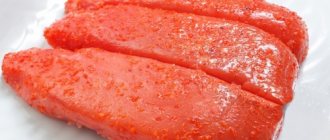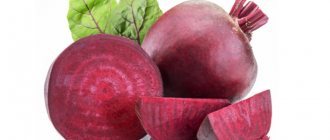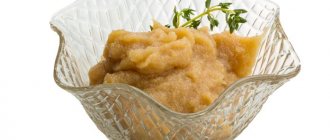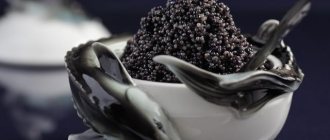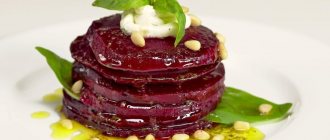4 recipes for caviar from boiled beets.
The easiest and fastest way to prepare caviar is from boiled beets, because the time it takes to bring this root vegetable to readiness is saved several times. You need to cook the beets in a saucepan with water for 2-2.5 hours, depending on their size. It is not recommended to pierce with a knife until this time has passed, so that its beautiful red juice does not come out. For the same purpose, under no circumstances should you cut off the tail of beets and the place where the tops grew from before cooking. Very often boiled beets are left over from preparing salads and vinaigrettes, and then making beet caviar from it is the best option.
4 recipes for caviar from boiled beets
1. Beet caviar from boiled beets with garlic.
This is a simple quick recipe for beetroot caviar, without frying onions and carrots, they are not included in the dish at all.
- 600 g beets
- 2 cloves garlic
- 2-3 tablespoons vegetable oil
- 1 teaspoon sugar
- 0.5 teaspoon salt
- lemon juice - 1 tbsp.
1. Boil the beets, cool, peel, cut into pieces and grind in a blender.
2. Place in a frying pan with butter, salt, add sugar and lemon juice (optional), mix and cook over low heat for 10-15 minutes until desired thickness, stirring.
3. A couple of minutes before readiness, add grated garlic.
4. Place into clean jars and store in the refrigerator until eaten.
2. Fried caviar from boiled beets.
- 3 boiled beets
- 2 onions
- 1 carrot
- 5-6 cloves of garlic
- 2 tablespoons tomato paste
- 2-3 tablespoons vegetable oil
- Italian herbs or other spice blend
- small hot pepper (optional)
- salt to taste
1. Peel the beets and grate them on a coarse grater.
2. Separately, pass the raw carrots through a coarse grater.
3. Finely chop the onion.
4. Chop the chili pepper very thinly and remove the seeds, they contain a lot of excess bitterness.
5. Heat the oil in a deep frying pan with a thick bottom and fry the onion until golden brown.
6. Add carrots to the onions and also fry them until golden.
7. Add the pepper and let it brown a little too.
8. Add grated beets, tomato paste, sprinkle with herbs, salt, squeeze out the garlic, stir quickly and continue cooking over medium heat so that the beet caviar is fried and not stewed.
After 10-15 minutes, the excess moisture will evaporate and the caviar will be ready.
3. Beet caviar boiled through a meat grinder.
- 0.5 kg of beets, onions, carrots and tomatoes
- 250 g fresh apples
- 0.5 tsp Sahara
- salt to taste
- vegetable oil
1. Boil, cool and peel the beets. Pass through a meat grinder.
2. Cut the onion into small cubes, grate the carrots and peeled apples on a coarse grater.
3. Fry the onion, carrots and apple until soft.
4. Peel the tomatoes and cut into small cubes.
5. Add to vegetables and simmer together for 5-7 minutes.
6. Add the beets and simmer until the liquid evaporates, about 20-30 minutes.
7. Salt the finished caviar, season with spices, you can add a little lemon juice.
4. How to prepare caviar from boiled beets for the winter.
- red beets - 3 pcs.
- onions - 2-3 pcs.
- tomato paste - 2 tablespoons
- sugar - 1 tablespoon
- vinegar 9% - 2 tablespoons
- salt and pepper to taste
- vegetable oil for frying
1. Boil the beets until tender, cool, peel and grate on a fine grater.
2. Finely chop the onion and fry in oil until golden brown.
3. Place the beets and simmer together for 5 minutes.
Beetroot caviar in 15 minutes - a tasty and healthy snack
In this recipe we will use pre-cooked beets. I recommend that you boil or bake it the night before so you can quickly make caviar out of it in the morning. But if you don’t have this opportunity, be sure to keep in mind that cooking beets takes about 40 minutes, depending on the size of the root vegetable. And plus another 15 minutes for it to cool down.
In addition to the fact that in this recipe we will use boiled beets, the addition of pickles will also be unusual. Very tasty recipe, be sure to try it.
Three ways to prepare beets:
- Boil in a saucepan: place the washed root vegetable in cold water, bring to a boil, then reduce the gas and cook over low heat. This process will take approximately 40 minutes.
- Bake: wrap the washed beets in foil and place in the oven preheated to 190 degrees for 50 minutes.
- The fastest way is to cook the vegetable in the microwave. We wash the beets and place them in a glass bowl, pour in 3 tablespoons of water. Cover the top with a microwave lid. Cooking time – 20 minutes. If you don't have a very powerful microwave, it will take a little longer.
The rest of the caviar preparation process will take no more than 15 minutes!
To prepare we will need:
- Beetroot – 300 g.
- Pickled cucumbers – 150 g.
- Onions – 2-3 pcs.
- Carrots – 1 pc.
- Garlic – 2 cloves
- Tomato sauce – 30 g.
- Salt, pepper - to taste
- Vegetable oil - for frying
1. Cut the onion into half rings, grate the carrots on a coarse grater.
2. Fry the onions and carrots in a frying pan greased with vegetable oil. Add tomato juice and simmer until tender for five minutes.
3. Peel the cucumbers (you don’t have to peel them). We pass all the ingredients through a meat grinder: beets, cucumbers, onions with carrots, garlic. Add salt and ground pepper. Mix everything well.
Red caviar: the benefits and harms of an exquisite delicacy, BJU
Salmon caviar (red caviar) has long been famous throughout the world as a favorite delicacy. This product has long been considered a symbol of prosperity, and many people dream of “having caviar in spoonfuls.” However, almost every family can now afford to enjoy this fish dish.
Types of red caviar
- The delicacy is given to us by salmon species: chum salmon, sockeye salmon, pink salmon, coho salmon, trout, Chinook salmon. The eggs are almost identical in their useful qualities, differing only in size, color and taste.
- The record holder for the size of grains is Chinook salmon, because the balls reach 7 mm in diameter, taste bitter and attract attention with their bright red color.
Interesting! You are unlikely to be able to appreciate the taste of Chinook salmon, because this species is listed in the Red Book.
- But chum salmon caviar is a dime a dozen on the market. In terms of egg size, this species is in second place with a diameter of 5-6 mm. Round balls of spherical regular shape with a rich amber hue, in which the germ spot is clearly visible. Until recently, it was called “royal”, but was used only for decorating dishes because of its specific fishy taste.
- Pink salmon is considered the most prolific fish. Due to its budget cost, pleasant taste and versatility, this type is a leader among the favorites of consumers around the world. The size of the grains is about 5 mm in diameter, the shell is not very dense and orange in color.
- Sockeye salmon eggs resemble pink salmon in taste, but the size is much smaller - only 4 mm, and it is extremely difficult to find them due to the long-term mass extermination of this fish by poachers, even during their spawning.
- Trout is the most widely sold fish to the public in recent years. The diameter of the balls is only 2-3 mm, and the color varies from yellow to bright orange.
- The grains of coho salmon are small, burgundy in color with a bitter aftertaste.
Interesting! Remember that flying fish caviar, which is so advertised by lovers of rolls and sushi, is colorless by nature and has nothing to do with the product we are considering. Only the sauces and spices that are included in the Japanese dish color the grains predominantly in a bright red color. At the request of the sushi chef, the balls can become black, blue and even purple.
Chemical composition and calorie content of red caviar
The benefits for human health are determined by the unique composition of the product. This is a real storehouse of polyunsaturated fatty acids and vitamins. The notorious omega-3 fatty acids are responsible for blood circulation, and the easily digestible protein in the composition only benefits the skin and muscle tissue. The BJU of the product looks like this:
- proteins - 24.6 g;
- fats - 17.9 g;
- carbohydrates - 0 g.
The nutritional value is supplemented as follows:
- ash - 6.5 g;
- water - 48 g;
- saturated fatty acids - 4.06 g;
- cholesterol - 588 mg.
Vitamins contained in the composition (mg):
- A- 0.271;
- B1- 0.19;
- B2- 0.62;
- B5- 3.5;
- B6- 0.32;
- B9- 50 mcg;
- B12- 20 mcg;
- D- 0.1724 μg;
- E- 1.89;
- K - 0.6 mcg;
- PP- 0.12;
- choline - 490.9.
Calorie content of the product (100 g serving): 252 kcal, which makes caviar dishes impossible to call dietary. The already high energy value is aggravated by the fact that caviar is eaten with baked goods, eggs and butter.
Minerals and trace elements in caviar
Red caviar is the bearer of all the richness of the periodic table of Mendeleev. Nutrients allow the body to function properly throughout the day.
Macroelements are represented by the following types (mg):
- sodium - 1500;
- phosphorus - 356;
- magnesium - 300;
- calcium - 275;
- potassium - 181.
Microelements, as well as minerals, are necessary for a person to work and improve immunity.
- iron - 12 mg;
- zinc - 0.95 mg;
- manganese - 0.05;
- copper - 110 mcg;
- selenium - 66 mcg.
The glycemic index of this fish product is zero, and all due to the fact that the composition is completely free of carbohydrates.
The benefits of the delicacy for the body
If you understand in detail what the benefits and harms of the product are for humans, then you only need to understand that the egg is, in fact, a fish egg, which contains the entire necessary set of nutrients for the normal development of the embryo inside. And as you know, nature is not a person, and cannot make mistakes. The delicacy contributes to:
- improving visual acuity;
- strengthening the immune system, which is why doctors strongly recommend introducing dishes to patients with oncology and during the period of receiving radiation therapy;
- prevention of thrombosis in small and large vessels;
- strengthening the walls of blood vessels and increasing their elasticity;
- strengthening bone tissue.
Important! Red caviar serves as an excellent prevention of cardiovascular diseases. We recommend regularly consuming this healthy product for people aged 40 years and above. You can add raw vegetables, lettuce or boiled eggs.
Is there any harm from caviar?
Even though the product in question is so beneficial, before use you should find out whether there is any harm to the human body. Please note that there are still restrictions.
- Don't overeat. The "spoons" parameter is not allowed. 2-3 sandwiches or 5 teaspoons without a slide and without top will be sufficient to get the required dose of nutrients.
- A large amount of sodium in the composition can cause disruption of metabolic processes.
- If you are a fan of canapes made from fried croutons and butter, then get ready for fasting days. A dangerous combination of butter, flour products and high-calorie caviar will lead to excess weight gain.
- Doctors quite often prohibit the use of grains in their “pure” form for people with diagnosed kidney diseases. This is not surprising, because the product contains too much salt.
How to choose the “right” delicacy
The coveted amber grains are sold in a variety of packaging, so the issue of choosing the right one is very pressing. And given the high cost of caviar, it would be very annoying to purchase a rotten or tasteless product.
Selection of products in tins
If possible, try to avoid such a purchase. You will be lucky if in the jar you find just a second-rate small-sized product, crushed and glued together. The worst outcome is a terrible odor, which will be evidence of spoilage of the grains. If there is no other choice, then here are some parameters that you should pay attention to.
- a clear preservation date must be stamped on the lid;
- salmon fish spawn between July and September, so this period should be reflected in the date;
- shake the jar in your hands, if you hear “gurgling” sounds, this is a clear sign of product spoilage.
Product in glass containers
This option is better than a tin, but also not ideal.
- turn the container over, the grains should not immediately slide down;
- there should be no liquid in the jar, because this is evidence of the manufacturer’s dishonesty or the oil in the composition;
- give preference to factories from the Far East or Kamchatka and the Kuril Islands.
Selection of loose caviar
A smart purchase. In this case, you see the “product in person”, you can taste the grains, not the taste, feel the consistency. Feel free to ask the seller for a quality certificate. The freshness of the product lasts for a period of 5 days.
Remember! A quality product of the 1st grade has a uniform color, a pleasant smell, a taste without foreign impurities, strong grains without settled water and spoiled eggs. This rule applies to all varieties except coho salmon and sockeye salmon. The latter allow some heterogeneity of grains and bitterness in taste.
Red caviar is not only very tasty, but also incredibly healthy. Know the rules of consumption and enjoy the exquisite taste of the delicacy without harm to your health.
: The benefits and harms of red caviar
Source: https://gotovite.ru/anatomiya-pishhi/krasnaya-ikra-polza-i-vred-izyskannogo-delikatesa-bzhu.html
Beetroot caviar in a slow cooker
I would like to offer you a quick and simple recipe for making beetroot caviar in a slow cooker. Cooking in this way is more like delicately stewing food, and the taste of caviar is very delicate.
To prepare we will need:
- Beets – 3-4 pcs.
- Carrots – 1-2 pcs.
- Onions – 1-2 pcs.
- Garlic – 1 clove
- Tomato paste – 100 g.
- Sugar – 1 teaspoon
- Olive oil – 1 tbsp. spoon
1. First, wash the vegetables. Peel the beets, carrots and garlic and chop them on a fine grater. Finely chop the onion.
2. Set the multicooker to fry for 10 minutes. We wait 2 minutes until the bowl warms up, pour olive oil into it, and send the onion to brown. As soon as the onion is browned, add the garlic and fry for two minutes.
3. Add carrots and beets to the bowl with the onions and mix everything.
Add tomato paste (you can add one teaspoon of sugar to it if desired).
4. Set the “Extinguishing” function for 50 minutes. Close the lid. You can stir it a couple of times during the entire simmering period.
How many calories are in red caviar, and what are its benefits?
In a number of eastern countries, red caviar used to be the main food for sled dogs. It was also used as an adhesive. But it became known as a delicacy much later. Initially, when red caviar appeared in St. Petersburg, no one appreciated its taste. But after salting, many people loved the taste of eggs. Today we will discuss how many calories are in red caviar.
Popular delicacy: calorie content and composition
Today, red caviar can be bought without problems. There are various varieties of this delicacy on the tables - pink salmon, sockeye salmon, salmon, trout.
There is also Chinook fish, which is considered the most expensive and delicious, but you won’t be able to try it, since it is included in the Red Book. Salmon caviar is in great demand, as is pink salmon product.
How many calories are in red pink salmon caviar? Its nutritional value varies from 230 to 270 kilocalories per 100 g of product.
How many calories are in a spoon of red caviar? A tablespoon weighing about 18 g contains up to 45 kilocalories, but a teaspoon weighing approximately 8 g has the nutritional value of red caviar reaching 20 kilocalories.
This delicious product is used to prepare delicious snacks and, of course, sandwiches. How many calories are in a sandwich with red caviar? If we are talking about a classic sandwich made from a slice of wheat bread and butter, then its energy value reaches 65 kilocalories.
As you can see, this product is quite high in calories, but it is rarely eaten in large quantities, so there is no need to worry about the possibility of gaining weight from red caviar.
Separately, it is necessary to highlight the composition of caviar. Most of it is protein. There are also carbohydrates and healthy fats. Red caviar has an amazing, diverse composition.
Chemical composition:
- selenium;
- cyanocobalamin;
- copper;
- vitamin D;
- sodium;
- potassium;
- ferrum;
- riboflavin;
- calcium;
- pantothenic and folic acids;
- magnesium;
- retinol;
- vitamin B1;
- phosphorus;
- vitamin B4;
- tocopherol;
- vitamin B6.
On a note! Some varieties of this delicacy contain record amounts of nicotinic acid. A 100 g serving contains about 34 g of vitamin PP, which satisfies a third of the daily requirement for this element.
In addition to the above components, caviar contains ash, water, and cholesterol, which is beneficial. There are also fatty acids that are necessary for the human body.
Red caviar contains very few carbohydrates, so the glycemic index of this delicious product is almost zero.
What you need to know about the benefits and harms?
Despite the enormous benefits and amazing taste of red caviar, you don’t need to eat it every day. Some doctors say that the delicacy should be consumed at intervals of 1-2 months. The daily norm is no more than 40 g, which is equal to five teaspoons.
Since red caviar is eaten extremely rarely in its pure form, and most often the product becomes an additional ingredient in a sandwich, you can eat no more than 2-3 slices of bread per day without harm to your figure and health.
You have already appreciated the amazing component composition of fish caviar. It is the presence of such micro- and macroelements that makes it healthy and nutritious.
Benefits of caviar:
- replenishment of Omega fatty acid deficiency;
- improvement of hematopoietic function;
- promoting the production of red blood cells;
- improvement of the condition of the skin, hair and nail plates;
- removing free radicals from the body;
- prevention of the appearance of malignant neoplasms;
- strengthening the immune system;
- improvement of visual function;
- replenishment of calcium and vitamin D deficiency;
- prevention of osteoporosis;
- strengthening bone tissue;
- maintaining muscle tone;
- rapid and complete absorption of protein;
- promoting a speedy recovery after serious illnesses and surgical interventions.
Red caviar, a well-known delicacy in our country, is incredibly healthy for both sexes. Consuming this product daily has a beneficial effect on the brain and activates its processes.
On a note! Scientists have concluded that eating red caviar is an excellent remedy for the prevention of Alzheimer's disease and sclerosis.
Women love red caviar, because consuming it helps maintain the health of their hair and skin. This delicacy is also incredibly useful during pregnancy. The eggs contain all the necessary nutrients, vitamins, minerals, micro- and macroelements needed by the expectant mother and baby.
Men should also pay attention to this product. Eating red caviar helps produce hormones and maintain normal hormonal levels.
But there is also another side to the coin. Red caviar can harm humans.
Important! The concentration of vitamin B12 in a serving of red caviar is almost six times more than what a person needs to consume per day. Such an excess can lead to the development of complicated consequences - anaphylactic shock, pulmonary edema, heart failure.
Don't forget that caviar contains sodium. This element retains fluid inside, which can result in swelling. Therefore, for people prone to edema, the amount of red caviar consumed should be minimized.
There are no direct contraindications to introducing this delicacy into the diet, but there are people who are at risk.
List of ailments:
- ischemic diseases;
- increased blood pressure;
- overweight;
- atherosclerosis.
Important! The above conditions require special caution when consuming red caviar.
Source: https://mnogoli.ru/skolko-kalorij-v-krasnoj-ikre-iv-chem-ee-polza
Beetroot caviar as in kindergarten with tomato paste
In this preparation, the caviar tastes very much like the one we ate in kindergartens. Both cold and hot, it is always eaten with gusto.
To prepare we will need:
- Beetroot – 500 g.
- Onions – 200 g.
- Tomato paste – 50 g.
- Sugar – 2 tbsp. spoons
- Salt – 1.5 tbsp. spoons
- Ground black pepper – 0.5 teaspoon
- Vegetable oil for frying vegetables
- Butter – 50 g.
1. Three raw beets on a fine grater and fry for 5-7 minutes in a frying pan in vegetable oil.
2. Cut the small onion into small cubes, fry in a separate frying pan for 4-5 minutes until transparent.
3. Mix the vegetables in one frying pan, add salt, sugar, tomato paste, mix. Cover with a lid and simmer for 15 minutes.
4. Add seasonings, add butter, mix.
Fry for another two minutes and you're done! Cool the caviar.
Video of cooking fried beet caviar with onions and carrots
A very tasty recipe for caviar, which I cook very often. Simple and hassle-free. I grind raw beets in a blender in 3 minutes; you can grind all the vegetables at the same time, but I like the onions to be fried separately. Thanks to fine chopping, vegetables are fried in a frying pan very quickly.
Below you can watch a detailed video recipe.
To prepare we will need:
- Beetroot – 1 kg.
- Carrots – 2 pcs.
- Onion – 1 pc.
- Garlic – 3-5 cloves
- Vegetable oil
- Salt, spices (bay leaf, ground pepper - to taste).
Watch the cooking video:
Fried beet caviar, recipe like in the USSR
In caviar prepared according to this recipe, all ingredients will be visible in separate pieces. There are sweet peppers, carrots, onions, and tomato paste.
This kind of caviar was very popular during the Soviet era because it was delicious, you could cook a lot of it, and the vegetables cost mere pennies. She decorated the table for almost every holiday! If you miss that time, cook this dish! It will take you approximately 40 minutes to cook.
To prepare we will need:
- Beetroot – 1 kg.
- Sweet pepper – 1 pc.
- Tomato paste – 2 tbsp. spoons
- Bay leaf – 1 pc.
- Peppercorns – 10 g.
- Onion – 1 pc.
- Carrots – 1 pc.
- Lemon juice – 1 tbsp. spoon
- Sugar – 2 tbsp. spoons
- Vegetable oil
- Salt
1. Let's start with beets: grate the raw vegetable and fry it in a frying pan greased with vegetable oil.
2. After about five minutes, squeeze lemon juice onto the beets, add salt, sugar, and mix. Cover with a lid and cook until done.
3. Cut the onion into large pieces (it will be tastier this way), fry in a frying pan separately from the beets. Three carrots on a coarse grater and add to the onion. We also throw a bay leaf there. Carrots quickly absorb oil, make sure that the vegetables do not start to burn. I love it when there is a lot of butter.
Red caviar: calorie content per 100 g, proteins, fats, carbohydrates
Energy value (calorie content) of Red caviar is 249 Kcal
per 100 grams of product (edible part).
The ratio of proteins, fats and carbohydrates: PropertyValue
| Calorie content, kcal | 249 |
| Proteins, g | 31,5 |
| Carbohydrates, g | 1 |
| Fats, gr | 13,2 |
Product calculator
Enter the amount of “Red Caviar” product to calculate its nutritional value
Property Value % of normal
| Calorie content, kcal | 249 | 12.45 | 12.45% |
| Proteins, g | 31,5 | 20.67 | 20.67% |
| Carbohydrates, g | 1 | 0.4 | 0.4% |
| Fats, gr | 13,2 | 29.55 | 29.55% |
Cod caviar. Beneficial features
Cod caviar is a private guest on our table, because its price is affordable for most of us. It’s sad, but many do not perceive this product as the basis of proper nutrition and a healthy lifestyle. In terms of usefulness, cod eggs are in no way behind red or black eggs.
The taste of caviar is a little dry, but at the same time pleasant and tender. Use caviar everywhere: for sandwiches, in salads, for snacks. Choose a well-preserved product, since the eggs have a limited shelf life.
The composition includes vitamins A, D, C, PP, B, which are easily absorbed. In addition, with caviar your body receives potassium, protein, Omega-3 (which is no less than in the liver) and a sea of antioxidants (girls, take note).
- The benefits of cod caviar are almost the same as those of salmon, however, we note its special role in maintaining healthy skin and teeth, due to its high content of antioxidants.
- People with high cholesterol should enjoy cod. Thanks to lecithin, it is able to fight this disease.
- Don’t give up cod caviar if you have poor hematopoiesis
- Cod caviar can normalize upset digestion and improve metabolism.
- Magnesium helps the nervous system, which is why caviar has received a second name - “mineral of calm.”
- Zinc comes to the aid of the reproductive system.
- Doctors recommend caviar for consumption by people of all ages, because its role for the body as a whole is invaluable.
Like salmon caviar, cod caviar has contraindications. Hypertensive patients and people with gastrointestinal diseases should not consume the treat in large quantities.
Kinds
Beluga caviar is considered the best ; it is the largest caviar. However, it is almost impossible to find it. First of all, because beluga spawns in its fifteenth year! Catching wild sturgeon is strictly prohibited, and caviar can only be obtained from artificially farmed fish.
Black caviar comes in two types: milk caviar and slaughter caviar .
Milk
In order not to wait several years for caviar, producers inject the fish with drugs that accelerate its release. Then the fish is milked, following the example of a cow. This kind of caviar is very fragile due to the fact that the eggs come out with many small holes.
To strengthen such caviar, manufacturers add preservatives, which leads to a loss of taste and quality of the finished product.
Benefit
Black caviar is rightly called “black gold”, being the most nutritious product, balanced in composition for human nutrition, not to mention its extraordinary taste.
The benefits of black caviar are clear, because it contains almost all the vitamins and elements necessary for a person. It contains up to 13% fat and about 30% easily digestible proteins, folic acid, valuable amino acids, lecithin, and many vitamins. Among them:
- Vitamin A , so necessary for a person to see and maintain the immune system.
- Vitamins B1, B2, B5, B6 and B9 are needed for normal metabolism and the functioning of all organs.
- Vitamin B12 is essential for the proper functioning of the nervous system.
- Vitamins C and E fight viruses and cancer cells.
- vitamin D to prevent rickets and the functioning of the endocrine system.
- Choline has nootropic, antidepressant and sedative effects.
Delicious caviar contains the following minerals:
- Magnesium.
- Potassium.
- Zinc.
- Sodium.
- Phosphorus.
- Manganese.
- Iodine.
- Iron.
- Calcium.
- Silicon.
Due to the high content of polyunsaturated Omega-3 fatty acids, eating caviar:
- Has a beneficial effect on brain function.
- Helps cope with iron deficiency.
- Improves memory.
- Reduces the risk of blood clots.
- Has a positive effect on vision.
- Increases immunity.
- Prevents the occurrence of cancerous tumors.
- Normalizes blood circulation.
- Stabilizes the state of the nervous system.
- Useful for people with cardiovascular diseases.
The undeniable benefit of black caviar is that it contains easily digestible animal proteins , with which our body receives the necessary amino acids.
Currently, many cosmetics based on black caviar are produced. This is due to the fact that it activates the production of collagen, which is responsible for the strength of the skin.
Of course, sturgeon caviar is not a medicine, but due to its high content of nutrients, it is perfect for prevention and general strengthening of the body.
Black caviar is not only an expensive delicacy, but also a healthy product.
Harm
Despite all the benefits, black caviar has its drawbacks.
Lots of salt
First of all, in order to preserve the caviar, it is salted in a saline solution. Since it is impossible to sterilize such a delicate product, the manufacturer has to add salt in the amount necessary to preserve the product. Salt in this case acts as the only preservative, due to which the consumer receives a highly salted product.
It's no secret that too much salt:
- It retains fluid in the body, which causes swelling, and also negatively affects the functioning of the kidneys and urinary system.
- Causes an increase in blood pressure, which negatively affects the state of the cardiac system.
- May cause osteoporosis - demineralization of bones.
- Thickens the blood and slows down circulation.
It is important to remember that to replenish salt losses, a person needs to take only 2-6 grams of salt per day .
Presence of preservatives
The natural shelf life of caviar is 4 months . In order to preserve it for up to a year, manufacturers add preservatives. For this, methenamine (E239) and sorbic acid (E200) are used, which are permitted, but not harmless.
Preservatives are known to cause:
- Allergies.
- Headache.
- Stomach diseases.
- Development of malignant tumors.
- Decreased functioning of the immune system.
Not environmentally friendly
Black caviar has one more drawback - it is not environmentally friendly. Unfortunately, a large percentage of sturgeon fish on the Russian market are caught by poachers, which in itself is a crime against nature.
Added to this is the impossibility of storing such a product in proper conditions, which can lead to poisoning and other disorders.
Red caviar: benefits and harm, calorie content. Natural red caviar: how is it useful and to whom exactly, and to whom is it harmful to consume it?
The fashion for red caviar came to Russia from the Far East.
Local residents did not consider it some special delicacy, and even now the price of a jar of high-quality caviar depends largely on the delivery of the product.
Source: https://yazdorov.win/vitaminy/krasnaya-ikra-kalorijnost-na-100-g-belki-zhiry-uglevody.html
Boiled beet caviar
The easiest and fastest way to prepare beet caviar. Beets must be cooked or baked in advance. In this recipe we will use a grater, but you can alternatively grind the beets with a blender, then you will get a very delicate texture.
To prepare we will need:
- Beets – 5-6 small pieces. (approximately 1 kg.)
- Onion – 3 pcs.
- Tomato sauce – 3 tbsp. spoons
- Salt, pepper - to taste
- Sunflower oil for frying
1. Wash, boil or bake the beets, peel them. Three on a fine grater.
2. Finely chop the onion. Place in a frying pan with vegetable oil.
3. When the onion is fried until golden brown, add beets to it, mix, salt and pepper. Add three tablespoons of tomato sauce. Simmer it all for 10-15 minutes, stirring occasionally.
Beetroot caviar, as an excellent appetizer, is prepared from a minimal set of ingredients in several ways. A blender, food processor, regular grater or meat grinder may be required. Read on...
- home
- Catalog
- Best selections
- Preparations for the winter
- Vegetable preparations
- Beets for the winter
- Beet caviar
Beetroot caviar: how to cook and how to store
Beets for caviar can be boiled, baked in the oven whole, and then processed in the chosen way. It can also be grated raw, and then simmered in a frying pan with seasonings until cooked. There are recipes with different cooking technologies, the choice is yours.
The five most commonly used ingredients in beet caviar recipes are:
| Product | Calories kcal per 100g | Proteins g per 100g | Fats g per 100g | Carbohydrates g per 100g |
| Beet | 49 | 2 | 11 | |
| Bulb onions | 41 | 1.4 | 10.4 | |
| Vinegar | 11 | 3 | ||
| Carrot | 33 | 1.3 | 0.1 | 6.9 |
| Tomato paste | 28 | 5.6 | 1.5 | 16.7 |
The easiest way is to boil beets in water or steam. Then chop with a blender, season and roll into jars. The minimum set of ingredients is as follows: beets, onions, garlic, salt and selected spices. As a rule, the juice of the beets itself is enough to make the dish juicy. And there is no need to add additional sauces or liquids. For taste, tomato paste is allowed in moderate quantities so as not to over-acidify. Preservatives include vinegar, salt, sugar, and vegetable oil.
A richer option in addition to the listed products are: carrots, bell peppers, tomatoes. The dish will take longer to simmer.
The caviar is ground to a baby puree, grated on a fine, medium or coarse grater. If you scroll with a meat grinder, you will get uniform pieces. Often this is the caviar that turns out to be the most delicious.
Sometimes you come across beet tubers that are too watery. They advise baking, not boiling. And if they give too much juice, the excess is drained. When finished, caviar should have such a consistency that it can be spread on pieces of bread without any problems.
Five of the lowest calorie beet caviar recipes:
| Name of the dish | Cooking time | Calories kcal per 100g | User rating |
| Fried beet caviar with carrots and garlic | 1 h 5 min | 46 | +54 |
| Beet caviar with tomato paste | 40 min | 47 | +331 |
| Buryak (beet) caviar | 1 hour 45 minutes | 66 | +59 |
| Squash caviar with beets | 1 hour | 79 | +63 |
| Beetroot caviar with ginger | 40 min | 107 | +82 |
Another way to combat moisture-laden beets is to add a little corn or rice flour to the dish. It absorbs excess perfectly.
You can store caviar in a tightly sealed container in the refrigerator. Or roll into sterilized jars as usual.
- remember that beets stain not only clothes, but also hands, and for a long time; therefore, prepare caviar using thin rubber gloves (medical gloves are suitable)
Answers to frequently asked questions
Below are the main questions regarding the use of beets.
- Is beet juice healthy? The juice contains a lot of vitamins and minerals, but lacks fiber. Drinking juice on an empty stomach or against the background of chronic diseases of the stomach and duodenum can cause irritation of the mucous membranes of the digestive tract. It is recommended to take the juice together with other types of food in order to prevent possible complications.
- Application of leaves (tops). Beet leaves contain significantly more vitamins and fiber. Typically, the tops are used to reduce body weight and normalize cholesterol levels in the blood. Tops can be added to salads and other dishes.
- Consumption of kvass. In folk medicine, beet-based kvass is used to lower blood pressure and improve digestion. There is currently no scientific data that would confirm such properties.
- Use of decoction. Beetroot broth has pronounced antibacterial properties and anti-inflammatory activity. It is usually used for infectious and inflammatory diseases of the intestines and upper respiratory tract.


